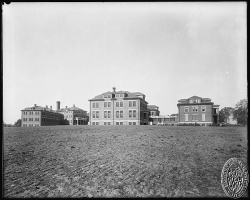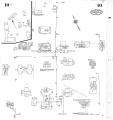Rosewood State Hospital
| Rosewood State Hospital | |
|---|---|
 | |
| Established | 1888 |
| Opened | 1889 |
| Closed | 2009 |
| Current Status | Closed |
| Building Style | Cottage Plan |
| Architect(s) | Jackson C. Gott/J. Crawford Nielson |
| Location | Owings Mills, MD |
| Architecture Style | Classical & Georgian Revival |
| Alternate Names |
|
Contents
History[edit]
The Maryland Asylum and Training School for Feeble-minded was incorporated by the General Assembly in 1888, and its name was changed by the General Assembly of 1912 to Rosewood State Training School. It is a permanent charitable institution, owned and entirely supported by the State of Maryland.
The movement to establish a training school for feeble-minded patients had its origin largely in the efforts of Dr. Richard Gundry, then superintendent of the Spring Grove State Hospital, who in several reports called the attention of the state to the great need of doing something for the care and training of feeble-minded children. In consequence of his initiative, much interest was developed in several public-spirited philanthropists, among whom were Dr. J. Pembroke Thom, Gen. Herman Stump and Milton G. Urner. A small appropriation was obtained to establish such a school in the former residence of Dr. Wood, of the Navy, near Owings Mills, known as Rosewood. The first superintendent was Miss Martha M. Gundry, a daughter of Dr. Gundry, who, with a single teacher, opened the school in a small way in 1888. Miss Gundry continued in responsible charge for several years, and resigned to establish a school in Virginia. She was succeeded by several medical gentlemen, who held the office for comparatively brief periods. Dr. Thom continued much interested, and two of the cottages, Pembroke and Thom, bear his name. Gen. Herman Stump and Milton G. Urner are still connected with the board. Later the full development of the institution resulted in the appointment of Dr. F. W. Keating, who has been responsible for its work for the past 16 years.
The object of the institution is to furnish a home and a practical education for the feeble-minded children of the state who are not provided for in the public schools. Many children are of such defective understanding as to render them incapable of receiving proper training in the public schools, where they are brought into competition with those of normal intellect and where they cannot receive the especial care and attention absolutely necessary to secure mental development. In most instances they require training specially adapted to their condition, or they will become a burden upon their friends or the community; but by receiving kind and painstaking care and tuition at the hands of competent, experienced persons many of them become partly self-supporting under proper supervision. To care for and train such children to accomplish the results indicated, is the purpose of this institution.
Rosewood is situated about one-half mile from Owings Mills, in Baltimore County,. and is accessible by the Western Maryland Railroad and the Emory Grove electric cars. It is in the Green Spring Valley, and is beautifully and healthfully located upon a farm of 537 acres of land.
Children between the ages of 7 and 17 years who, by reason of mental defect, cannot be educated in ordinary schools, and who are not insane or greatly afflicted or deformed physically, are admitted into the institution free of charge for board and tuition, upon evidence being furnished of their inability to pay. Reasonable compensation is charged to those able to pay. It has a capacity of 700 children.
The group of buildings consists of a main or administration building and cottages which have been added from time to time, furnishing accommodation for 492 inmates, a school building and the necessary farm structures. In addition a custodial building for girls of low-grade type was completed in the spring of 1914, providing additional accommodations for 260 girls. This building is furnished with dormitories, day rooms, toilet and bath rooms, dining rooms and a scullery. On the first and second floors are large sleeping porches and in the basement is a large play room, which is used in inclement weather. The third floor is occupied by the nurses and attendants in the building, each having a separate bedroom, with a general sitting room for their comfort when not on duty with the children.
In the same year other improvements were made on the grounds. Two new stone barns and a large terra cotta silo were erected to replace old wooden structures, at a total cost of $10,584.41. An attractive stone gate lodge, with stone gateway, was also completed, at a cost of $3554, which adds greatly to the appearance of this entrance to the grounds.
The majority of the patients admitted are children under 15 years of age, at a time when they are susceptible of improvement by school instruction.
In the school department much attention is paid to manual training for the more advanced pupils and to kindergarten instruction for the younger ones. Each child is accorded the full advantages of class-room training when he or she is admitted to the institution within the limits of the school age. In the household department, sewing room, dining room, kitchen and laundry the work is entered into with much interest on the part of the patients. Their desire is great to do " something like work," and the improvement made in this branch of their training calls for still greater effort in the future, for such training saves them from a life of idleness and is one of the most important factors in developing the feebleminded along lines of economic efficiency.
The farming and clearing of land have been of substantial benefit to the boys, and the good derived from this work cannot be too highly estimated. The produce raised on the farm has furnished the institution with a supply of fresh vegetables at all seasons. The entire supply of milk is obtained from the school's own herd, and a great deal of the fresh meat has been obtained from the live stock fattened and butchered on the farm. During the biennial period of 1913-14 the market value of the farm products aggregated $32,923.63; also the value at local prices of work performed by farm teams in hauling and excavating would amount to $3977.10. The work on the farm furnishes one of the most effective means of developing, both mentally and physically, the boys committed to the institution. Some of those most useful on the farm were able to accomplish practically nothing in the school room, but the outdoor occupation seems to render them particularly docile and happy.
The per capita expense for maintenance during the period of 1913-14 was $4.58 weekly, an increase of 15 cents per patient over the preceding biennial period, which increase is due to the advance in the market price of many supplies and the general increase in the wages of employees.[1]
SUPERINTENDENTS
- Miss Mattie M. Gundry.February 19, 1889, to April 4, 1892.
- Dr. B. D. Evans April 4, 1892, to May 30, 1892.
- Dr. B. A. Turner June 15, 1892, to May 7, 1895.
- Dr- L. Gibbons Smart. June 5, 1895, to August 31, 1896.
- Dr. Frank W. Keating. .October 1, 1896[2]
Between the 1950s and 1970s, as in many similar state-run institutions in the United States, there were numerous reports of malpractice, neglect and abuse. In 1981, the U.S. Justice Department declared that residents at Rosewood "failed to receive minimally adequate care".[3] Further investigations proved positive leading to the older hospital buildings being vacated and condemned in 1989.
The original administration building was destroyed by fire in a 2006 case of arson, the building had been vacant at the time of the fire. Another fire destroyed an additional vacant building on Sunday, March 8, 2009, the building had previously been approved for demolition, so firefighters allowed the building to burn rather than attempt to put it out.[4] The Maryland State Fire Marshal investigated the fire as possible arson.[5]
January 2008, Governor O'Malley announced a phased closure of the Rosewood Center. The decision to close Rosewood followed the Department of Health and Mental Hygiene's report Rosewood Center - Plan for Services to Residents. The report concluded that the vast majority of individuals who currently live at Rosewood could be served in the community. The report also identified the need for secure facilities and specific programs designed to meet the needs of the individuals with developmental disabilities committed to DHMH by the courts.[6] The State of Maryland Department of Health and Mental Hygiene closed Rosewood on June 30, 2009. As of June 8, 2017, Stevenson University has announced that they were granted permission to acquire the Rosewood Center. Their plans include the development of the area to turn it into an educational and athletic site for SU students.
Images of Rosewood State Hospital[edit]
Main Image Gallery: Rosewood State Hospital
Links & Additional Information[edit]
References[edit]
- ↑ http://books.google.com/books?id=dC4wAAAAYAAJ&dq=the%20institutional%20care%20of%20the%20insane&client=firefox-a&pg=PA573#v=onepage&q=&f=false
- ↑ http://books.google.com/books?id=dC4wAAAAYAAJ&dq=the%20institutional%20care%20of%20the%20insane&client=firefox-a&pg=PA573#v=onepage&q=&f=false
- ↑ Rosewood Center facing U.S. civil rights investigation. Scharper, Julie. Baltimore Sun. August 20, 2008. Retrieved on 2009-03-23.
- ↑ Fire destroys vacant building at Rosewood. Irwin, Richard. Baltimore Sun. March 9, 2009. Retrieved on 2009-03-23.
- ↑ Fire breaks out in two abandoned Rosewood Center buildings. Zumer, Bryna. Catonsville Times. March 9, 2009. Retrieved on 2009-03-23.
- ↑ http://www.ddamaryland.org/rosewood






